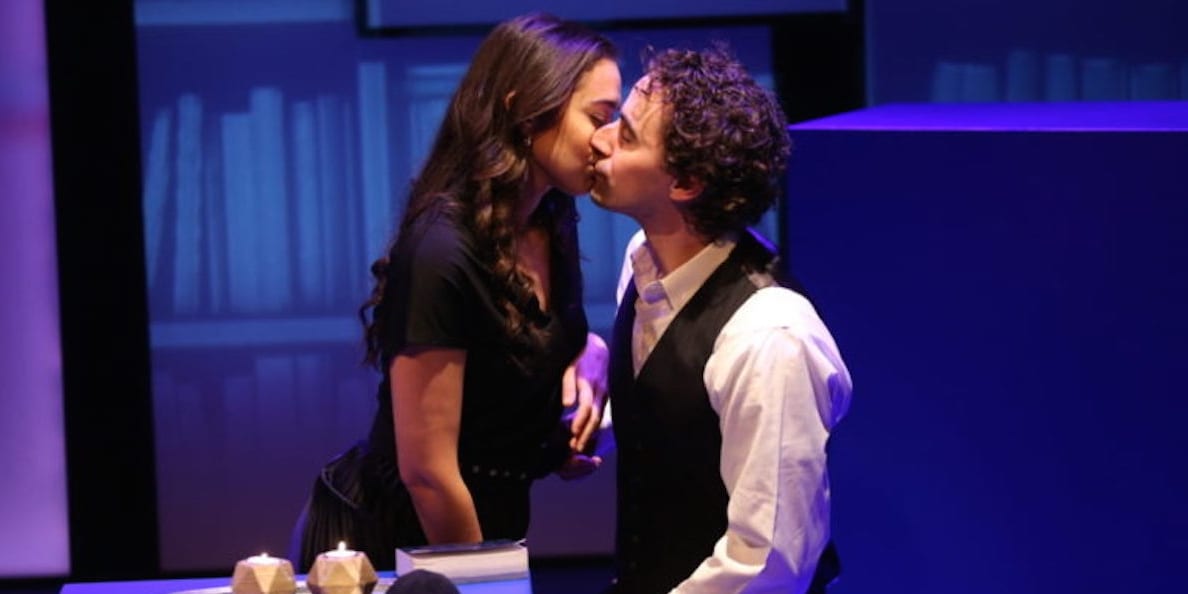How many goys does it take to screw in a lightbulb on a Friday night? For one lonely Orthodox Jew it’s one beautiful Italian neighbor. That’s the premise of Cary Gitter’s comedy, The Sabbath Girl, now playing at 59E59. It was originally produced by Penguin Rep Theatre and directed by its Artistic Director, Joe Brancato, who also directs this production at 59E59 Theaters. It’s a common romantic story of love overcoming cultural differences comedy, but in this case, with a dash of New York City humor.
Angie Mastrantoni (in a delicately nuanced performance by Lauren Annunziata) works in a successful hip art gallery in Chelsea. This is evidenced by her being able to move into an Upper West Side apartment. She has relationship problems. But then what 30 something New Yorker doesn’t? Down the hall is her neighbor, Seth, who works in a family-owned knish store with his sister, Rachel, (Lauren Singerman) on the Lower East Side and is translating a Yiddish writer. He has relationship problems too. But then what divorced Orthodox Jew doesn’t?
It’s a hot Friday night in June. Seth’s usual shabbos goy, the Korean Mr. Lee, has moved out of his apartment. (A shabbos goy, is a Yiddish term to describe a non-Jewish individual needed to do tasks forbidden to Jews during the Sabbath.) The new tenant, Angie, obliges Seth’s plea to turn on his AC and later to replace a light bulb. And so we have in Gitter’s words, “a great set-up for a romantic comedy.”
The journey for these culture-crossed lovers is filled with a few obstacles which Angie’s Italian grandmother (Angelina Fiordellisi) knows will be overcome by love, just love. She tells that it will conquer all, including Seth’s Jewishness: “I’ll take an Orthodox Jew with love in his heart over an artist with icicles in his veins any day.”
Seth, on the other hand, must come to terms with his faith and family. First, is Seth’s sister and co-owner of the knish store on the Lower Eastside. Rachel presents the traditional argument to mixed marriages. It a serious threat to community and Jewish tradition: “ You’re an Orthodox Jew. You’re part of a community. What’re you gonna do, ask out Angie the Italian?”
Angie is temporarily distracted from romance with Seth by her attraction to a young edgy painter, Blake (Ty Molbak). Despite his obnoxious egotism, his work in Angie’s eyes is amazing: “You peer into people’s souls – into the anxiety of what it means to be alive in the 21st century.” He is sufficiently, in his words, “wooed” by this and attempts to seduce her. Bare-chested and with an impressive dancer’s lift, Angie is swept across the stage in one of the play’s liveliest scenes.

The structure of the play is made up of several 2-person scenes in multiple and are repeated locations – Angie’s apartment, Seth’s apartment, Angie’s art gallery, Seth’s knish store, a park and an artist’s loft. The quick scene shifts are enhanced by both Yana Birykova effective locale projections and the utilitarian set made up of simple blue cubes by scenic designers Christopher and Justin Swader.
Gitter’s play is in the tradition of sweet and sentimental rom coms. There are no surprises here, no unexpected twists or turns, no deep dark secrets revealed. What saves The Sabbath Girl from being just a cliché-ridden play about two lonely people from different cultures who overcome those differences with love is not the play’s plot but Gitter’s delightful characters and dialogue. In this day where vulgarity prevails in our society, gender diversity is expected, or dark and disturbing secrets inhabit thrillers it comes as a relief to find a romantic comedy that is straightforward in its message of love and its delightful humor that is Cary Gitter’s The Sabbath Girl.
Still, the inevitable questions remain: Will a culturally mixed marriage survive? How will the children be raised? But I’m sure the playwright would have high hopes for its sequel given that he dedicated to and was obviously inspired by the memory of his grandmother, Teresa Frances Golden.

